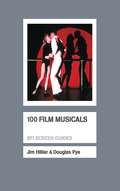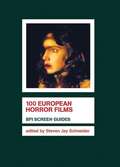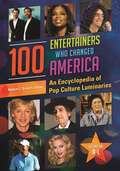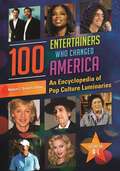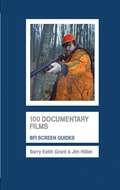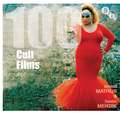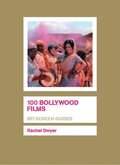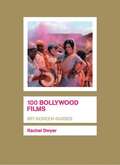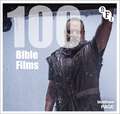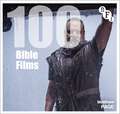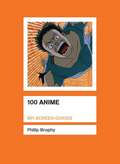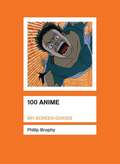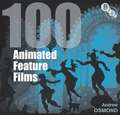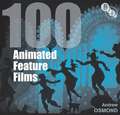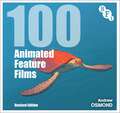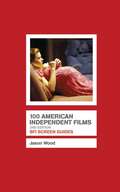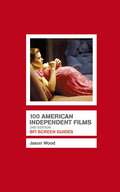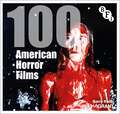- Table View
- List View
100 Film Musicals (Screen Guides)
by Douglas Pye Jim HillierFrom the coming of sound to the 1960s, the musical was central to Hollywood production. Exhibiting – often in spectacular fashion – the remarkable resources of the Hollywood studios, musicals came to epitomise the very idea of 'light entertainment'. Films like Top Hat and 42nd Street, Meet Me in St. Louis and On the Town, Singin' in the Rain and Oklahoma!, West Side Story and The Sound of Music were hugely popular, yet were commonly regarded by cultural commentators as trivial and escapist. It was the 1970s before serious study of the Hollywood musical began to change critical attitudes and foster an interest in musical films produced in other cultures. Hollywood musicals have become less common, but the genre persists and both academic interest in and fond nostalgia for the musical shows no signs of abating. 100 Film Musicals provides a stimulating overview of the genre's development, its major themes and the critical debates it has provoked. While centred on the dominant Hollywood tradition, 100 Film Musicals includes films from countries that often tried to emulate the Hollywood style, like Britain and Germany, as well as from very different cultures like India, Egypt and Japan. Jim Hillier and Douglas Pye also discuss post-1960s films from many different sources which adapt and reflect on the conventions of the genre, including recent examples such as Moulin Rouge! and High School Musical, demonstrating that the genre is still very much alive.
100 Exercises to Get You Into Drama School: Improve your acting and audition skills
by Jona Howl'The book's main asset is its clarity and accessibility, it relates to its readers in a helpful and clear way.' John Gillett, actor trainer and author of Acting on ImpulseCompetition for drama school is fierce, thousands apply every year for only a few places. Preparing well for your audition is key.This book gives drama-school hopefuls the inside track only previously available via professional coaches. It gives clear advice on improving acting skills through effective exercises in which voice, movement, text and character come together with a single aim: to pass that elusive audition and get your career off the ground.Content and acting workshops include: posture, movement, the Alexander Technique, voice, how to work with the text, how to prepare for the Big Day, how to behave on the day. A resource section for places of study is also included.With specific exercises designed by a top London drama school coach, this book will help you think and feel like an actor. Get into training for auditions in film, TV or theatre today!
100 European Horror Films (Screen Guides)
by Steven Jay SchneiderFrom bloodsucking schoolgirls to flesh-eating zombies, and from psychopathic killers to beasts from hell, '100 European Horror Films' provides a lively and illuminating guide to a hundred key horror movies from the 1920s to the present day. Alongside films from countries particularly associated with horror production - notably Germany, Italy, and Spain and movies by key horror filmmakers such as Mario Bava, Dario Argento, and Lucio Fulci, '100 European Horror Films' also includes films from countries as diverse as Denmark, Belgium, and the Soviet Union, and filmmakers such as Bergman, Polanski and Claire Denis, more commonly associated with art cinema. The book features entries representing key horror subgenres such as the Italian 'giallo' thrillers of the late 60s and 70s, psychological thrillers, and zombie, cannibal, and vampire movies. Each entry includes a plot synopsis, major credits, and a commentary on the film's significance, together with its production and exhibition history. Films covered in the book include early classics such as Paul Wegener's 'The Golem,' Robert Wiene's 'The Cabinet of Dr. Caligari,' and 'Murnau's Nosferatu'; 70s horror favorites such as 'Daughters of Darkness, The Beast,' and 'Suspiria'; and notable recent releases such as 'The Devil's Backbone, Malefique,' and 'The Vanishing.'
100 European Horror Films (Screen Guides)
From bloodsucking schoolgirls to flesh-eating zombies, and from psychopathic killers to beasts from hell, '100 European Horror Films' provides a lively and illuminating guide to a hundred key horror movies from the 1920s to the present day. Alongside films from countries particularly associated with horror production - notably Germany, Italy, and Spain and movies by key horror filmmakers such as Mario Bava, Dario Argento, and Lucio Fulci, '100 European Horror Films' also includes films from countries as diverse as Denmark, Belgium, and the Soviet Union, and filmmakers such as Bergman, Polanski and Claire Denis, more commonly associated with art cinema. The book features entries representing key horror subgenres such as the Italian 'giallo' thrillers of the late 60s and 70s, psychological thrillers, and zombie, cannibal, and vampire movies. Each entry includes a plot synopsis, major credits, and a commentary on the film's significance, together with its production and exhibition history. Films covered in the book include early classics such as Paul Wegener's 'The Golem,' Robert Wiene's 'The Cabinet of Dr. Caligari,' and 'Murnau's Nosferatu'; 70s horror favorites such as 'Daughters of Darkness, The Beast,' and 'Suspiria'; and notable recent releases such as 'The Devil's Backbone, Malefique,' and 'The Vanishing.'
100 Entertainers Who Changed America [2 volumes]: An Encyclopedia of Pop Culture Luminaries [2 volumes]
by Robert C. SickelsThis fascinating and thought-provoking read challenges readers to consider entertainers and entertainment in new ways, and highlights figures from outside the worlds of film, television, and music as influential "pop stars."Comprising approximately 100 entries from more than 50 contributors from a variety of fields, this book covers a wide historical swath of entertainment figures chosen primarily for their lasting influence on American popular culture, not their popularity. The result is a unique collection that spotlights a vastly different array of figures than would normally be included in a collection of this nature—and appeals to readers ranging from high school students to professionals researching specific entertainers.Each subject individual's influence on popular culture is analyzed from the context of his or her time to the present in a lively and engaging way and through a variety of intellectual approaches. Many entries examine commonly discussed figures' influence on popular culture in ways not normally seen—for example, the widespread appeal of Woody Allen's essay collections to other comedians; or the effect of cinematic adaptations of Tennessee Williams' plays in breaking down Hollywood censorship.
100 Entertainers Who Changed America [2 volumes]: An Encyclopedia of Pop Culture Luminaries [2 volumes]
by Robert C. SickelsThis fascinating and thought-provoking read challenges readers to consider entertainers and entertainment in new ways, and highlights figures from outside the worlds of film, television, and music as influential "pop stars."Comprising approximately 100 entries from more than 50 contributors from a variety of fields, this book covers a wide historical swath of entertainment figures chosen primarily for their lasting influence on American popular culture, not their popularity. The result is a unique collection that spotlights a vastly different array of figures than would normally be included in a collection of this nature—and appeals to readers ranging from high school students to professionals researching specific entertainers.Each subject individual's influence on popular culture is analyzed from the context of his or her time to the present in a lively and engaging way and through a variety of intellectual approaches. Many entries examine commonly discussed figures' influence on popular culture in ways not normally seen—for example, the widespread appeal of Woody Allen's essay collections to other comedians; or the effect of cinematic adaptations of Tennessee Williams' plays in breaking down Hollywood censorship.
100 Documentary Films (Screen Guides)
by Barry Keith Grant Jim HillierDocumentary films constitute a major part of film history. Cinema's origins lie, arguably, more in non-fiction than fiction, and documentary represents the other - often submerged and barely visible - 'half' of cinema history. Historically, documentary cinema has always been an important point of reference for fiction cinema, and the two have often overlapped. Over the last two decades, documentary cinema has enjoyed a revival in critical and commercial success.100 Documentary Films is the first book to offer concise and authoritative individual critical commentaries on some of the key documentary films - from the Lumière brothers and the beginnings of cinema through to recent films such as Bowling for Columbine and When the Levees Broke - and is global in perspective. Many different types of documentary are discussed, as well as films by major documentary directors, including Robert Flaherty, Humphrey Jennings, Jean Rouch, Dziga Vertov, Errol Morris, Nick Broomfield and Michael Moore. Each entry provides concise critical analysis, while frequent cross reference to other films featured helps to place films in their historical and aesthetic contexts.Barry Keith Grant is Professor of Film Studies and Popular Culture at Brock University, Ontario, Canada. He is the author of Film Genre: From Iconography to Ideology (2007), Voyages of Discovery: The Cinema of Frederick Wiseman (1992) and co-author, with Steve Blandford and Jim Hillier, of The Film Studies Dictionary (2001).Jim Hillier is Visiting Lecturer in Film at the University of Reading. He is the author of The New Hollywood (1993), the co-author of The Film Studies Dictionary (2001) and, with Alan Lovell, of Studies in Documentary (1972). His edited books include American Independent Cinema (2001) and two volumes of the English translation of the selected Cahiers du cinema (1985, 1986).
100 Cult Films (Screen Guides)
by Ernest Mathijs Xavier MendikSome films should never have been made. They are too unsettling, too dangerous, too challenging, too outrageous and even too badly made to be let loose on unsuspecting audiences.Yet these films, from the shocking Cannibal Holocaust to the apocalyptic Donnie Darko, from the destructive Tetsuo to the awfully bad The Room, from the hilarious This Is Spinal Tap to the campy Showgirls, from the asylum of Das Cabinet des Dr. Caligari to the circus of Freaks, from the gangs of The Warriors to the gangsters of In Bruges and from the flamboyant Rocky Horror Picture Show to the ultimate cool of The Big Lebowski, have all garnered passionate fan followings.Cult cinema has made tragic misfits, monsters and cyborgs, such as Edward Scissorhands or Blade Runner's replicants, heroes of our times. 100 Cult Films explains why these figures continue to inspire fans around the globe. Cult film experts Ernest Mathijs and Xavier Mendik round up the most cultish of giallo, blaxploitation, anime, sexploitation, zombie, vampire and werewolf films, exploring both the cults that live hidden inside the underground (Nekromantik, Café Flesh) and the cult side of the mainstream (Dirty Dancing, The Lord of the Rings, and even The Sound of Music).100 Cult Films is a true trip around the world, providing a lively and illuminating guide to films from more than a dozen countries, across nine decades, representing a wide range of genres and key cult directors such as David Cronenberg, Terry Gilliam and David Lynch. Drawing on exclusive interviews with some of the world's most iconic cult creators and performers, including Dario Argento, Pupi Avati, Alex Cox, Ruggero Deodato, Jesús Franco, Lloyd Kaufman, Harry Kümel, H. G. Lewis, Christina Lindberg, Takashi Miike, Franco Nero, George A. Romero and Brian Yuzna, and featuring a foreword by cult director Joe Dante, 100 Cult Films is your ultimate ticket to the midnight movie show.
100 British Documentaries: Bfi Screen Guides (Screen Guides)
by Patrick RussellEver since John Grierson popularized the term 'documentary,' British non-fiction film has been renowned, sometimes reviled, but seldom properly appreciated. '100 British Documentaries 'provides a uniquely accessible, occasionally provocative introduction to a rich and surprisingly varied tradition by considering 100 examples taken from across a century's worth of output. The 100 films range from the Victorian period to the present day. Alongside such classics as 'Night Mail 'and 'Touching the Void 'are documentaries that illustrate the many uses to which it has been put from pro-gram-filler to political propaganda to classroom teaching aid and the many styles and viewpoints it has embraced. While the focus is on the documentary 'film,' several television productions are included, indicating how the genre has developed on the small screen.
100 British Documentaries (Screen Guides)
by Patrick RussellEver since John Grierson popularized the term 'documentary,' British non-fiction film has been renowned, sometimes reviled, but seldom properly appreciated. '100 British Documentaries 'provides a uniquely accessible, occasionally provocative introduction to a rich and surprisingly varied tradition by considering 100 examples taken from across a century's worth of output. The 100 films range from the Victorian period to the present day. Alongside such classics as 'Night Mail 'and 'Touching the Void 'are documentaries that illustrate the many uses to which it has been put from pro-gram-filler to political propaganda to classroom teaching aid and the many styles and viewpoints it has embraced. While the focus is on the documentary 'film,' several television productions are included, indicating how the genre has developed on the small screen.
100 Bollywood Films (Screen Guides)
by Rachel DwyerBollywood film is the national cinema of India, describing movies made in Mumbai, distributed nationally across India and with their own production, distribution and exhibition networks worldwide. This informative screen guide reflects the work of key directors, major stars and important music directors and screenplay writers. Historically important films have been included along with certain cult movies and top box office successes. No guide to Hindi film would be complete without discussing: Mother India, the national epic of a peasant woman's struggle against nature and society to bring up her family; Sholay, a 'curry western' where the all-star cast sing and dance, romance and kill; Dilwale Dulhaniya le jayenge, the greatest of the diaspora films, in which two British Asians fall in love on a holiday in Europe before going to India where they show their elders how to incorporate love into family traditions; Junglee, showing how love transforms a 'savage' (junglee) who yells 'Yahoo!' before singing and dancing like Elvis, creating a new youth culture; Pyaasa, dramatically shot in black and white film with haunting songs as the romantic poet suffers for his art in the material world; Fans of Bollywood film can debate Rachel Dwyer's personal selection of these 101 titles while those new to the area will find this an invaluable introduction to the best of the genre.
100 Bollywood Films (Screen Guides)
by Rachel DwyerBollywood film is the national cinema of India, describing movies made in Mumbai, distributed nationally across India and with their own production, distribution and exhibition networks worldwide. This informative screen guide reflects the work of key directors, major stars and important music directors and screenplay writers. Historically important films have been included along with certain cult movies and top box office successes. No guide to Hindi film would be complete without discussing: Mother India, the national epic of a peasant woman's struggle against nature and society to bring up her family; Sholay, a 'curry western' where the all-star cast sing and dance, romance and kill; Dilwale Dulhaniya le jayenge, the greatest of the diaspora films, in which two British Asians fall in love on a holiday in Europe before going to India where they show their elders how to incorporate love into family traditions; Junglee, showing how love transforms a 'savage' (junglee) who yells 'Yahoo!' before singing and dancing like Elvis, creating a new youth culture; Pyaasa, dramatically shot in black and white film with haunting songs as the romantic poet suffers for his art in the material world; Fans of Bollywood film can debate Rachel Dwyer's personal selection of these 101 titles while those new to the area will find this an invaluable introduction to the best of the genre.
100 Bible Films (BFI Screen Guides)
by Matthew PageFrom The Passion of the Christ to Life of Brian, and from The Ten Commandments to Last Temptation of Christ, filmmakers have been adapting the stories of the Bible for over 120 years, from first time the Höritz Passion Play was filmed in the Czech Republic back in 1897. Ever since, these stories have inspired musicals, comedies, sci-fi, surrealist visions and the avant garde not to mention spawning their own genre, the biblical epic. Filmmakers across six continents and from all kinds of religious perspectives (or none at all), have adapted the greatest stories ever told, delighting some and infuriating others.100 Bible Films is the indispensible guide to this wide and varied output, providing an authoritative but accessible history of biblical adaptations through one hundred of the most interesting and significant biblical films. Richly illustrated with film stills, this book depicts how such films have undertaken a complex negotiation between art, commerce, entertainment and religion.Matthew Page traces the screen history of the biblical stories from the very earliest silent passion plays, via the golden ages of the biblical epic, through to more innovative and controversial later films as well as covering significant TV adaptations. He discusses films made not only by some of our greatest filmmakers, artists such as Martin Scorsese, Jean Luc Godard, Alice Guy, Roberto Rossellini, Pier Paolo Pasolini, Lotte Reiniger, Carl Dreyer and Luis Buñuel, but also those looking to explore their faith or share it with lovers of cinema the world over.
100 Bible Films (BFI Screen Guides)
by Matthew PageFrom The Passion of the Christ to Life of Brian, and from The Ten Commandments to Last Temptation of Christ, filmmakers have been adapting the stories of the Bible for over 120 years, from first time the Höritz Passion Play was filmed in the Czech Republic back in 1897. Ever since, these stories have inspired musicals, comedies, sci-fi, surrealist visions and the avant garde not to mention spawning their own genre, the biblical epic. Filmmakers across six continents and from all kinds of religious perspectives (or none at all), have adapted the greatest stories ever told, delighting some and infuriating others.100 Bible Films is the indispensible guide to this wide and varied output, providing an authoritative but accessible history of biblical adaptations through one hundred of the most interesting and significant biblical films. Richly illustrated with film stills, this book depicts how such films have undertaken a complex negotiation between art, commerce, entertainment and religion.Matthew Page traces the screen history of the biblical stories from the very earliest silent passion plays, via the golden ages of the biblical epic, through to more innovative and controversial later films as well as covering significant TV adaptations. He discusses films made not only by some of our greatest filmmakers, artists such as Martin Scorsese, Jean Luc Godard, Alice Guy, Roberto Rossellini, Pier Paolo Pasolini, Lotte Reiniger, Carl Dreyer and Luis Buñuel, but also those looking to explore their faith or share it with lovers of cinema the world over.
100 Anime (Screen Guides)
by Philip BrophyAn exploration of the wonderfully complex and beautifully disorienting world of Japanese animation - anime. Provides an overview of the importance of the anime industry in Japan by analysing 100 of its most important and influential productions. An ideal introduction to a fascinating genre.
100 Anime (Screen Guides)
by Philip BrophyAn exploration of the wonderfully complex and beautifully disorienting world of Japanese animation - anime. Provides an overview of the importance of the anime industry in Japan by analysing 100 of its most important and influential productions. An ideal introduction to a fascinating genre.
100 Animated Feature Films (Screen Guides)
by Andrew OsmondTwenty years ago, animated features were widely perceived as cartoons for children. Today, though, they encompass an astonishing range of films, styles and techniques. There is the powerful adult drama of Waltz with Bashir; the Gallic sophistication of Belleville Rendez-Vous; the eye-popping violence of Japan's Akira; and the stop-motion whimsy of Wallace & Gromit in The Curse of the Were-Rabbit. Andrew Osmond provides an entertaining and illuminating guide to the endlessly diverse world of animated features, with entries on 100 of the most interesting and important animated films from around the world, from the 1920s to the present day.There are key studio brands such as Disney, Pixar and Dreamworks, but there are also recognised auteur directors such as America's Brad Bird (The Incredibles) and Japan's Hayao Miyazaki (Spirited Away). Technologies such as motion-capture, used in films such as Avatar, blur the distinctions between live-action and animation. Meanwhile, lone artists such as Nina Paley (Sita Sings the Blues) and Bill Plympton (Idiots and Angels) make entire films by themselves.Blending in-depth history and criticism, 100 Animated Feature Films balances the blockbusters with local success stories from Eastern Europe to Hong Kong. There are entries on Dreamworks' Shrek, Pixar's Toy Story, and Disney's The Jungle Book, but you will also find pieces on Germany's silhouette-based The Adventures of Prince Achmed, the oldest surviving animated feature; on the thirty year production of Richard Williams' legendary opus, The Thief and the Cobbler; and on the lost work of Argentina's Quirino Cristiani, who reputedly made the first animated feature in 1917.
100 Animated Feature Films (Screen Guides)
by Andrew OsmondTwenty years ago, animated features were widely perceived as cartoons for children. Today, though, they encompass an astonishing range of films, styles and techniques. There is the powerful adult drama of Waltz with Bashir; the Gallic sophistication of Belleville Rendez-Vous; the eye-popping violence of Japan's Akira; and the stop-motion whimsy of Wallace & Gromit in The Curse of the Were-Rabbit. Andrew Osmond provides an entertaining and illuminating guide to the endlessly diverse world of animated features, with entries on 100 of the most interesting and important animated films from around the world, from the 1920s to the present day.There are key studio brands such as Disney, Pixar and Dreamworks, but there are also recognised auteur directors such as America's Brad Bird (The Incredibles) and Japan's Hayao Miyazaki (Spirited Away). Technologies such as motion-capture, used in films such as Avatar, blur the distinctions between live-action and animation. Meanwhile, lone artists such as Nina Paley (Sita Sings the Blues) and Bill Plympton (Idiots and Angels) make entire films by themselves.Blending in-depth history and criticism, 100 Animated Feature Films balances the blockbusters with local success stories from Eastern Europe to Hong Kong. There are entries on Dreamworks' Shrek, Pixar's Toy Story, and Disney's The Jungle Book, but you will also find pieces on Germany's silhouette-based The Adventures of Prince Achmed, the oldest surviving animated feature; on the thirty year production of Richard Williams' legendary opus, The Thief and the Cobbler; and on the lost work of Argentina's Quirino Cristiani, who reputedly made the first animated feature in 1917.
100 Animated Feature Films: Revised Edition (BFI Screen Guides)
by Andrew Osmond20 years ago, animated features were widely perceived as cartoons for children. Today, though, they encompass an astonishing range of films, styles and techniques. There is the powerful adult drama of Waltz with Bashir; the Gallic sophistication of Belleville Rendez-Vous; the eye-popping violence of Japan's Akira; and the stop-motion whimsy of Wallace & Gromit in The Curse of the Were-Rabbit. Andrew Osmond provides an entertaining and illuminating guide to the endlessly diverse world of animated features, with entries on 100 of the most interesting and important animated films from around the world, from the 1920s to the present day.Blending in-depth history and criticism, 100 Animated Feature Films balances the blockbusters with local success stories from Eastern Europe to Hong Kong. This revised and updated new edition addresses films that have been released since publication of the first edition, such as the mainstream hits Frozen, The Lego Movie and Spider-Man: Into the Spider Verse, as well as updated entries on franchises such as the Toy Story movies. It also covers bittersweet indy visions such as Don Hertzfeldt's It's Such a Beautiful Day, Charlie Kaufman's Anomalisa, Isao Takahata's Tale of the Princess Kaguya, the family saga The Wolf Children and the popular blockbuster Your Name. Osmond's wide-ranging selection also takes in the Irish fantasy Song of the Sea, France's I Lost My Body and Spain's Chico & Rita. Osmond's authoritative and entertaining entries combine with a contextualising introduction and key filmographic information to provide an essential guide to animated film.
100 Animated Feature Films: Revised Edition (BFI Screen Guides)
by Andrew Osmond20 years ago, animated features were widely perceived as cartoons for children. Today, though, they encompass an astonishing range of films, styles and techniques. There is the powerful adult drama of Waltz with Bashir; the Gallic sophistication of Belleville Rendez-Vous; the eye-popping violence of Japan's Akira; and the stop-motion whimsy of Wallace & Gromit in The Curse of the Were-Rabbit. Andrew Osmond provides an entertaining and illuminating guide to the endlessly diverse world of animated features, with entries on 100 of the most interesting and important animated films from around the world, from the 1920s to the present day.Blending in-depth history and criticism, 100 Animated Feature Films balances the blockbusters with local success stories from Eastern Europe to Hong Kong. This revised and updated new edition addresses films that have been released since publication of the first edition, such as the mainstream hits Frozen, The Lego Movie and Spider-Man: Into the Spider Verse, as well as updated entries on franchises such as the Toy Story movies. It also covers bittersweet indy visions such as Don Hertzfeldt's It's Such a Beautiful Day, Charlie Kaufman's Anomalisa, Isao Takahata's Tale of the Princess Kaguya, the family saga The Wolf Children and the popular blockbuster Your Name. Osmond's wide-ranging selection also takes in the Irish fantasy Song of the Sea, France's I Lost My Body and Spain's Chico & Rita. Osmond's authoritative and entertaining entries combine with a contextualising introduction and key filmographic information to provide an essential guide to animated film.
100 American Independent Films (Screen Guides #Vol. 102)
by Jason WoodThis revised and updated new edition provides a guide to 100 of the most interesting and influential American independent films, from Bonnie and Clyde to Junebug by way of Reservoir Dogs and The Blair With Project with an introduction to the genre and a rich selection of images from the films discussed, plus key credits.
100 American Independent Films (Screen Guides)
by Jason WoodThis revised and updated new edition provides a guide to 100 of the most interesting and influential American independent films, from Bonnie and Clyde to Junebug by way of Reservoir Dogs and The Blair With Project with an introduction to the genre and a rich selection of images from the films discussed, plus key credits.
100 American Independent Films (Screen Guides)
by Jason WoodThis revised and updated new edition provides a guide to 100 of the most interesting and influential American independent films, from Bonnie and Clyde to Junebug by way of Reservoir Dogs and The Blair With Project with an introduction to the genre and a rich selection of images from the films discussed, plus key credits.
100 American Horror Films (BFI Screen Guides)
by Barry Keith GrantIn 100 American Horror Films, Barry Keith Grant presents entries on 100 films from one of American cinema's longest-standing, most diverse and most popular genres, representing its rich history from the silent era - D.W. Griffith's The Avenging Conscience of 1915 - to contemporary productions - Jordan Peele's 2017 Get Out. In his introduction, Grant provides an overview of the genre's history, a context for the films addressed in the individual entries, and discusses the specific relations between American culture and horror. All of the entries are informed by the question of what makes the specific film being discussed a horror film, the importance of its place within the history of the genre, and, where relevant, the film is also contextualized within specifically American culture and history. Each entry also considers the film's most salient textual features, provides important insight into its production, and offers both established and original critical insight and interpretation.The 100 films selected for inclusion represent the broadest historical range, and are drawn from every decade of American film-making, movies from major and minor studios, examples of the different types or subgenres of horror, such as psychological thriller, monster terror, gothic horror, home invasion, torture porn, and parody, as well as the different types of horror monsters, including werewolves, vampires, zombies, mummies, mutants, ghosts, and serial killers.
100 American Horror Films (BFI Screen Guides)
by Barry Keith GrantIn 100 American Horror Films, Barry Keith Grant presents entries on 100 films from one of American cinema's longest-standing, most diverse and most popular genres, representing its rich history from the silent era - D.W. Griffith's The Avenging Conscience of 1915 - to contemporary productions - Jordan Peele's 2017 Get Out. In his introduction, Grant provides an overview of the genre's history, a context for the films addressed in the individual entries, and discusses the specific relations between American culture and horror. All of the entries are informed by the question of what makes the specific film being discussed a horror film, the importance of its place within the history of the genre, and, where relevant, the film is also contextualized within specifically American culture and history. Each entry also considers the film's most salient textual features, provides important insight into its production, and offers both established and original critical insight and interpretation.The 100 films selected for inclusion represent the broadest historical range, and are drawn from every decade of American film-making, movies from major and minor studios, examples of the different types or subgenres of horror, such as psychological thriller, monster terror, gothic horror, home invasion, torture porn, and parody, as well as the different types of horror monsters, including werewolves, vampires, zombies, mummies, mutants, ghosts, and serial killers.
